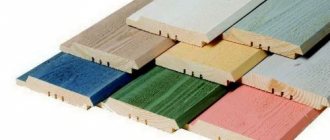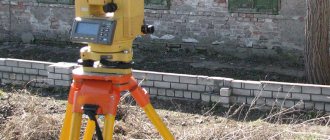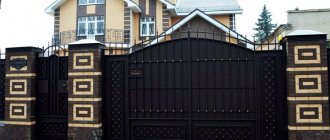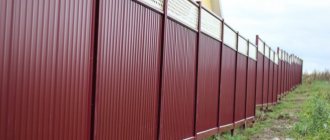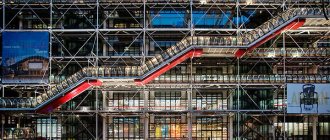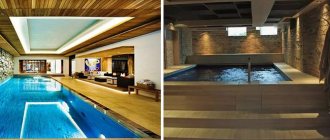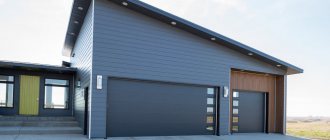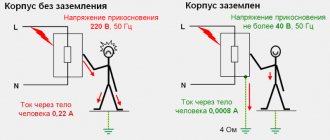What materials are usually used?
Stone
Most often, the fire pit is framed with natural stone - large cobblestones, slate, flagstone, sandstone. It is appropriate to simply stack them in a slide or fasten them together with a solution.
The good thing about stone is that it fits perfectly into the landscape and is inexpensive. And in mountainous areas the material can be obtained for free.
The stone can also be artificial, such as paving slabs or concrete blocks.
Brick
Brickwork is an excellent alternative to natural stone. Firstly, it is easy to buy (in addition, after construction there are often leftovers that can be used). Secondly, brick is a fire-resistant material, so a fireplace made from it will last for many years.
The photo shows a brick hearth
Metal
Cast iron or steel fire pits are purchased ready-made, so this option is more portable than stationary. In some cases, this is even more convenient, because... When it rains, you can move the fireplace under the roof.
On sale you can find skillfully made bowls with figured cutting in the form of various subjects - from natural motifs to strict geometric ones.
Concrete
An interesting modern option that you can make yourself is a concrete hearth. It is made according to the standard scheme of any concrete structures - the formwork is assembled, a reinforcing mesh is installed, and it is filled with liquid mortar.
The advantage of this method is that you can choose any size, wall thickness, side height.
The photo shows a fire pit made of concrete
Ceramic tile
Tile is essentially a finishing material, so to use it you will need a base - made of concrete, blocks or bricks. But with tiles or porcelain tiles you can beautifully decorate the recreation area, including the hearth itself and the area around it.
Rating of unusual ideas
Top 5 decisions on what to make a fire pit from:
- drum from the washing machine (you will first have to remove the central axis and plastic parts);
- portable fire in a jar;
- truck rim;
- fire pit made from a barrel. Actually not the best option, it will quickly collapse;
- tractor disk.
Open hearth
Gas fireplaces are not suitable for cooking because grease can damage the equipment.
But they have their advantages:
- fuel is environmentally friendly and inexpensive,
- easy to turn the fire on and off,
- flame strength is adjustable,
- no smoke
- fire is not afraid of rain.
Disadvantages of a gas fire:
- for cooking, many conditions must be observed, from a uniform flame to the shape of the pan;
- you need to replace the cylinder and check the equipment;
- It is difficult to make such a model with your own hands.
Fireplaces where wood is burned
The lounge area and fire pit with burning wood are easier to use. It is enough to put out the coals and forget about the fire until next time. But don’t forget the gas model, it needs to check the equipment for leaks.
A familiar hearth without sophisticated equipment will not be afraid of temperature changes; it can be lit once a year without worrying about its condition and safety.
Mobile fire pit
You can use a metal container or a large ceramic pot. Begin:
- We collect materials. You will need a ceramic pot or container with a rim, four glass photo frames of the same size, a metal mesh or grate, small pebbles, sealant, ignition for gel fireplaces;
- make a glass cube: remove the glass from the photo frames and glue the cube without a bottom with sealant;
- after drying, glue the cube to the bowl or container;
- Place a jar with ignition on the bottom of the bowl and cover with a net;
Important: the mesh needs to be cut to a size slightly larger than the perimeter of the bowl.
- decorate the mesh with stones.
Expert opinion
Levin Dmitry Konstantinovich
The hearth can be used indoors if you use the ignition for gel fireplaces. The gel will burn for no more than three hours, but can be re-lit.
Outdoor hearth-gabion
What do you need:
- one section of galvanized mesh for 3D fence;
- about a ton of large sea pebbles;
- crushed stone (place in the center);
- 2 square meters of galvanized sheet.
Stages of work:
- A small trench is filled with concrete three centimeters deep.
- Leave to stand for a day, moistening with water.
- Cut the fence section lengthwise and make a cylinder about 80 centimeters high and 120 centimeters in diameter.
- Broken brick or crushed stone is poured into the center, and pebbles are placed on the outside.
- Make an internal contour from the remains of the fence mesh; it will fix the fire pit.
- Close the gaps between the contours with stones.
How to do it yourself?
By preparing everything you need in advance, you can assemble a fire pit in just a few hours. We suggest considering the option of a simple stone hearth.
Check out our selection of DIY garden decor ideas.
Tools and materials
To work you will need:
- stone blocks;
- crushed stone;
- pebbles;
- shovel;
- slabs for laying out a circle;
- cement mortar or regular sealant.
Step-by-step instruction
First of all, choose a place, decide on the size of the future fire pit, and mark its center.
- Draw a circle of the required diameter.
- Remove 10-15 cm of soil (dig a small hole).
- Fill in 5-10 cm of gravel or crushed stone.
- Lay out the first row of blocks.
- If necessary, using sealant or mortar, lay out the second row, shifting the stones by a third or half relative to the bottom row.
- Lay out a few more rows until the desired result is achieved.
- Place paving slabs around the perimeter and fill the gap between the slabs and the fire pit with small stones.
Important! The sealant must be fireproof.
Do you want to have a recessed fireplace at your dacha? It’s even easier to set this up! For work you only need paving slabs and bricks. Watch the detailed video instructions and try it, everything will definitely work out.
Stone fire pit
An interesting option is stones that you can collect yourself from the surrounding forests, fields, and meadows. Natural materials are beautiful and free, which is undoubtedly a significant advantage. You will also need 1-1.5 bags of cement weighing 25 kg.
Construction will take 2-3 hours:
- The size of the hearth is determined similarly to the size of a brick fire pit. For example, take a circle with a diameter of 130 cm. Dig a hole 10 cm deep.
- Prepare the solution. A bag weighing 25 kg allows you to prepare 12.5 liters of ready-made solution. Simply mix the cement with water and sand according to the manufacturer's instructions, and the product is ready for use.
- In the outer circle we lay a thick layer of concrete mixture, and on it the first layer of stones. Then we place the second layer of stones with an outward offset of about 5 cm. This oven does not have vertical walls and expands smoothly. We also place a concrete mixture under the second layer of stones.
- The third layer protrudes above ground level. This natural boundary prevents the fire from spreading. The stones are laid one at a time, the laying process takes 1 hour. After a few days, the grass around the stones will grow and cover the excess concrete.
Ready hearth - photo
How to properly arrange it?
The first association associated with fire is firewood. It is logical to store them close to the hearth, so the firewood box should be located either next to the site or directly inside it. For convenience, you can provide benches with firewood under the seat or arrange a storage place directly in the structure of the fire pit.
Look at examples of beautiful firewood stacking.
The photo shows an option for storing firewood
The second association is rest. A vacant lot with a fire in the center has zero functionality; the fireplace is primarily a place for communication and relaxation. Therefore, next to it there should be sitting (or even lying!) places - benches, armchairs, chairs, chaise lounges, outdoor sofas or poufs.
For fire pits with cooking grates, it is necessary to provide a common table or individual tables so that there is somewhere to put a plate of food, a glass of wine or a cup of tea. As a common table, you can specifically expand the sides of the fire pit. Ideas for side tables include improvised objects, such as tree stumps or barrels.
To make the space truly cozy, do not forget about decor and lighting. The fire itself will serve as the main source of light; it can be supplemented with low solar-powered lanterns, garlands or candles.
Textiles (pillows, blankets), beautiful dishes (if cooking is provided) and decorative plants will help decorate the recreation area. Do not overdo it with the design; the main role should remain behind the fire.
How to put out a smoldering fire
Decorating bottles with your own hands (50 photos): original decoration ideas
The most commonly used methods of extinguishing a fire are to fill the fire pit with water and cover it with earth. The second option is advisable to use when there is a lack of water.
Your own urine can also be used for these purposes. And although such an act is not approved by many tourists, nevertheless, in conditions of survival I do not see anything wrong with it, especially if this is the only possible option to ensure fire safety.
Before extinguishing a fire with water, you should rake the coals so that they do not lie in a pile. Otherwise, still hot coals lying nearby may flare up again.
Sometimes, to extinguish a fire surrounded by stones, it is enough to simply collect the unburnt fuel in one pile in advance and allow it to burn completely, then distribute the coals in an even layer over the area of the fire and wait for them to cool. If the burning logs are large enough to burn out quickly, for example, in the case of a node, they can be moved away from each other, which will quickly lead to the cessation of burning and smoldering, unless the logs were rotten (these can smolder for many hours). If you additionally water them, they will stop burning and smoldering even faster.
Beautiful ideas for inspiration
To fit the fire area into the landscape design of the site, rely on natural elements: stone, wood. In this design, the space will look as natural as possible.
In the previous photo, the area is open, but if you wish, you can make it more intimate, for example, by surrounding it with an original fence in a circle.
The last tip concerns the arrangement itself. Instead of ordinary benches, for example, you can install a swing. And place the fire pit itself near the barbecue area or summer kitchen - this way you will simultaneously unite the spaces and separate the cooking area from the relaxation area.
As you may have noticed, setting up a fire pit is not difficult. But this simple element adds points to the design of any site: be it an ordinary dacha or an elite country house.
Outdoor fireplace made from scrap materials.
For those who like to use scrap materials, there are also beautiful options for an outdoor fireplace.
For example, you can make such a beautiful hearth from an old basin and the remains of stone and metal.
In fact, any durable metal will do for the inside of the fireplace.
This metal can be a washing machine tank.
For it to function, it is enough to weld the legs to it.
Or you can add minimal brickwork. It's not a lot of work, but the difference is noticeable.
Sometimes a fire pit is placed in a recess in the area - this technique is used for a windy or noisy area, this creates a more calm and quiet atmosphere around the fire pit.
Site preparation
If the site has dense sandy soils, excavation work can be eliminated. The second option for a simplified fire pit arrangement is an existing area, lined with paving slabs, stone, paved or concreted. On this base you can lay a couple of rows of brick or stone. Now the hearth is ready. This option is ideal for soils that do not drain water well. After rain, in such an area the sunken bowl under the fire will turn into a mini-pond and will dry for a very long time.
You can prepare the site like this... By the way, an interesting idea is to use concrete blocks, loading the voids with pebbles or crushed stone
In other cases, preparatory work cannot be done without. No, you can build a fire pit right on the ground, but after a few years it will become unusable - the walls will “creep” after rains or spring heaving of the soil. Preparing the site for a fire pit is standard:
- We remove the fertile layer of soil, remove roots and stones.
- We level and compact the soil.
- Pour a layer of crushed stone (not limestone, but granite) of medium and large fractions measuring 10-20 cm, level it, and tamp it.
You can already install a fireplace on this base, provided that you are satisfied with a crushed stone cushion as a base or you are going to pour concrete. True, for concrete you will need to assemble formwork around the perimeter. If you plan to pave the area around the fireplace with tiles or stones, pour sand or fine screenings onto the crushed stone. The sand/screenings are compacted, leveled, then tiles or stone are laid.
Crushed stone site is not so bad
On clay or fertile soils, so that the crushed stone does not “sink” into the ground, geotextiles with a density of 200-250 g/m are placed under it. This is a non-woven material that allows water to pass through, prevents roots from sprouting and prevents crushed stone from mixing with the soil. In fact, this is a very important layer that is best laid down.
Preface
The most important thing I learned from the whole construction of this fire pit is that there is no point in using flagstone. You will have to suffer a lot with him. But if you want to make a fire pit quickly, then you should install a wall block or stone veneer. You can also consider the option of paving slabs.
What tools did I need:
- shovel;
- one-wheeled car;
- Master OK;
- notched spatula;
- rake;
- circular saw (with a diamond blade for stone processing);
- geological hammer;
- stone chisel;
- hose;
- dust masks;
- level;
- sponges;
- buckets;
- rubber mallet;
- slaughterer
What materials I needed (approximately):
- cement mixture;
- mortar;
- concrete blocks;
- lining (it will stand between the blocks);
- fine gravel;
- thin flagstone;
- flagstone.
Let's start building the fire pit.
flagstone
Step 1. Dig a place for the fire pit
Before you start building a fire pit, you need to find a free area on which to place it. When a place is found, you need to dig an arc five meters wide and also five meters deep. It will later become the site for installing the wall of the fire pit.
After digging, you must remember to level the main part of the arc.
It is necessary to carefully prepare the place for the fireplace
Step 2. Fill the excavated area with concrete
When compiling a list of materials, I thought more than once about what kind of base I needed for the wall. I came to the conclusion that I would need a gravel base.
Once I had leveled the ground inside the dug arch, I took gravel and poured it there. Then I installed several bricks for rigidity of the future structure and “tiering”. Afterwards, I poured the cement mortar prepared in advance, and I poured it so that the height reached the very top of the excavation.
While the cement mortar was liquid, I leveled it as much as possible. After all, the next stage required the most even surface.
Concrete is a great way to hold everything in place.
Step 3. Dry masonry
Now that the cement mortar has hardened, you can install cement blocks. They are usually pre-installed using the dry masonry method. If the structure looks satisfactory and will stand strong enough, you can begin wet finishing using cement mortar.
To assess how the fire pit will look in the future, you can first set up cement blocks
Step 4: Wet finishing the cement blocks
When the wet finishing stage has begun, you need to mix 27-28 kilograms of cement mortar and 4.5 liters of water. The consistency should be viscous. Then you need to take a spatula and apply the composition to the surface of the cement blocks. Afterwards, pour cement mortar onto the open cells of the blocks for additional rigidity of the future structure.
Another row of such blocks was added behind for greater structural strength. They also installed pads there and then filled everything with an additional portion of cement mortar.
Note: if desired, you can use concrete adhesive instead of cement mortar. With him, perhaps the work will go faster.
Blocks can only be connected during the wet finishing process.
Step 5. Designate a space inside the fire pit (patio)
The patio of your fire pit may vary in shape and size. I decided to make it semicircular, although later it became completely round, and then completely turned into an oval.
Now you need to dig the same arc in the front part, and in the future it will become a support for cement blocks in front. These blocks will give the full shape of your fire pit patio.
Patio work requires a lot of attention and space
Important! If you don’t dig an arc, then one rainstorm is enough for all the work to go down the drain!
Step 6. Add a layer of sand and gravel
Once I had the wall in place at the front, I began decorating the patio.
I decided to use half a ton of gravel and spread it over a flat surface. The layer height should be about 10 centimeters. Then I used half a ton of sand and laid it in the same even layer. The thickness of the final layer will be about 7 centimeters.
You need to make a flat surface for the fire pit to look beautiful.
Step 7: Installing Stone Veneer
The first thing I did at this stage was apply mortar to the blocks and go over it with a notched trowel, making sort of scratches on its surface. This way I could ensure that I could attach the stone veneer more easily in the future. Then I applied the same solution in a small amount to each veneer, making a small gap in the middle.
Laying random stones horizontally and vertically from top to bottom, I made a random pattern and it looked like Mother Nature herself had tried.
To make sure this veneer was firmly fixed, I went over each stone with a rubber mallet. And where there were free spaces, I placed small stones and again walked with this mallet.
Worth knowing! It's best to do this after laying the floor. However, if you lack time, you can start earlier.
Installing stone veneer did not pose any difficulty
Step 8. Decorate the patio
When the stones on the walls lay at the same level and did not “tend” to fall out, I decided to work on the inside of the fire pit - the patio. To do this, I took the same stone veneer and gave it some shape and outline. I then applied cement to the sand and gravel layer and laid the stone veneer on top. Afterwards, I went over it with a rubber mallet and left the solution to dry.
The patio is as easy to design as the walls
Step 9. Installing the fire pit
Once everything was done, I moved on to the last step - setting up the fire pit. To do this, I took a fire brick and laid it out in a circle. Having secured it with mortar, I considered my project almost complete. But after the first ignition, I could confidently declare that the fire pit was completely ready for use.
This is what a fire pit looks like
I have been enjoying my beautiful handmade fire pit for a long time now. Guests, family and friends also loved him, and we often spend time together near him when it is no longer very cold outside.

